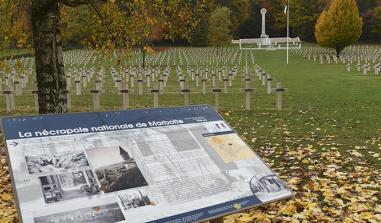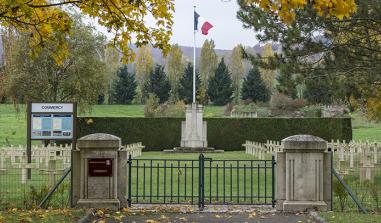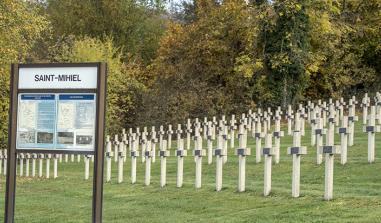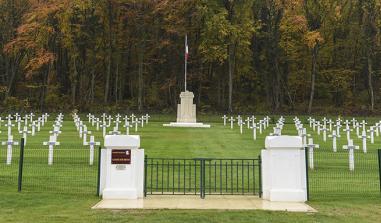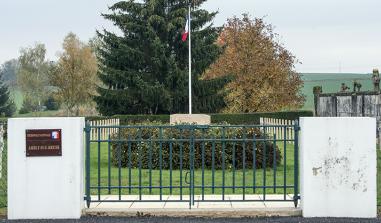The destroyed village of Louvement

Reconnaissance aérienne - Photo : collection Marc Vermot-Desroches. Source : Site Escadrille C53 - SPAbi 53
The village was destroyed in fighting of the First World War and never rebuilt. The Côte-du-Poivre remained in French hands...
History Lupinus-Mons (1041 ), Lupemons (1047), Lovus-Mons (1049), Lovonimons (1100), Lovemont (1242), Loupvemont, (1642), Louvemont then Louvemont-Côte-du-Poivre (1922) Patron saint: St-Pierre-ès-Liens: 1st August A very old village The village is located 11 km north of Verdun at the source of the Louvemont spring that winds through the countryside before flowing into the Meuse. It includes two isolated farms: Mormont and Haudromont. Located on an ancient lower order way, the site already existed in Gallo-roman times (2nd century). A church built in the 11th century was consecrated to St Peter by a Roman Bishop named Azon. In 1265, Robert de Milan, bishop of Verdun, made the village a free town. In the 17th century, the choir of a new church was built, joined by the nave and bell-tower in 1778. The village was laid out in a star shape: several roads converged on a square where the town hall-school was surrounded by the cemetery. In the 19th century, the population of the village reached its peak in 1846 (300 inhabitants), before gradually declining. 183 inhabitants in 1914 On the eve of the war, the Meuse directory listed: Owner-farmers: Beaumont E., Boulanger M., Colson E., Colson J., Louis C, Legendre E., Legendre M., Mazuet M., Mouteaux L, Siméon E. Inn-keepers: Lelorrain, Trouslard, Véry Tobacconist: Véry Baker: Colson Grocer: Trouslard. Novelties: Ligony Locksmiths: Jacquemin, Péridon, Véry Notable of private means: Geoffroy F. Forestry agent: Hargé Mayor, Cantonal Delegate and Member of the Consultative Chamber of Agriculture: Beaumont Deputy Mayor: Lefèvre A. School teacher: Bourguignon Priest: Abbé Jullot (Parish of Beaumont)
Five horrifying days of battle Following the Battle of the Borders (August 1914), the front was located 6.7km from the village, to the north of Beaumont. The future was uncertain for the inhabitants, who lived by the sound of canon fire. Movements for civilians were restricted, and a pass required to go anywhere. In October 1914, the front was pushed back a few kilometres by a French offensive, where it stabilized.
However, tension mounted again at the beginning of 1916. The Germans were about to attack, but where? When? Doubtless as soon as the first days of good weather appeared. On 12th February, the military authorities ordered the inhabitants of Louvemont to evacuate the town within 24 hours. The Prefecture for the Meuse had problems finding accommodation for the new refugees. Starting at 6.30 in the morning on 21st February 1916, Louvemont was subjected to a terrible bombardment. Following the fall of Le Bois des Caures, Beaumont and Ornes, Colonel Bourgues believed the village to be lost by the 24th. In fact the defenders of Louvemont resisted until the evening of the 25th: "The village was hell; at intervals of a few minutes, you would see the German artillery fire stretch out and an attacking wave would rush forward. The defenders would then come out with their bayonets, and everything would be lost in the smoke and the fine snow that had begun to fall. A few moments later, the same scene would begin again." Almost ten months before recapture For months, the area was the scene of fierce fighting: the Côte du Poivre was re-occupied, then lost once more. Finally, on 15th and 16th December 1916, General Mangin made a leap forward with four divisions, from Vacherauville to the Hardaumont wood; the Germans left the ruined Côte du Poivre, Louvemont and Bezonvaux for good.
1919 - After the war The happiness of peace... the desolation of homecoming With the Armistice signed, the refugees could not wait to return to their homes. Sadly, the 825 hectares of the completely destroyed village, were classified as a "red zone". It would be totally impossible for anybody to reinhabit the site, the reasons ranging from "risk of explosion" to "land poisoned". The entire commune was planted with spruce trees. The scattered inhabitants were re-housed in temporary wooden huts... until they were able to rebuild houses. In 1922, the inhabitants were at last able to go to the tax office in Bras in order to be paid for the requisitions made by the military during the war: live cows, hay, wood, etc. At that time, the town administration was still being handled by Rigny-la-Salle near Vaucouleurs. Keeping the memory alive On 9th September 1920, Louvemont was mentioned in dispatches by André Lefèvre, Minister for War. On 4th May 1930, Louvemont inaugurated a monument to its dead. Attended by Mr. Remy, Deputy Mayor of Louvemont, Mr. Colson, representing the former soldiers, Victor Schleiter, Mayor and Deputé for Verdun, Abbé Bonne, priest for Bras, and the population of Louvemont who had come from all over the region. A tribute to those who remain out of the thousands of men who lost their lives in the region, to the children of the area - Joseph Boulangé, Emile Colson, Joseph Colson, Georges Lefèvre, Jules Legendre, Ernest Siméon, Jules Simon and Trouslard -, as well as the two civilians, - Céline Jacquemin and Victor Caillas -, who refused to leave their village. On 31st July 1932, the Louvemont chapel was inaugurated. Located on the site of the demolished church, it keeps watch over the old cemetery, most of the graves from which could not be found. The chapel is adorned with two works by Lucien Lantier.
A plan to recreate aspects of the village in this verdant setting Thanks to a number of organisations, including the National Forestry Organisation, the Verdun Area local authorities, the inter-community body for the villages destroyed in 1916, the Municipal Commission of Louvemont, and the EAGGF, a number of different projects have offered visitors a chance to see what Louvemont might have been like. A double stand of limes and maples» line the route to the heart of the village from the road to Ornes, The spring with two pools, rebuilt using stone from the ruined village flows as it did before Behind the chapel wall, two lines of ash trees recall the Main Street, Stones give the outline of the Town Hall-school, Lastly the yew trees and giant Thuyas highlight the monument to the dead against a forest background.
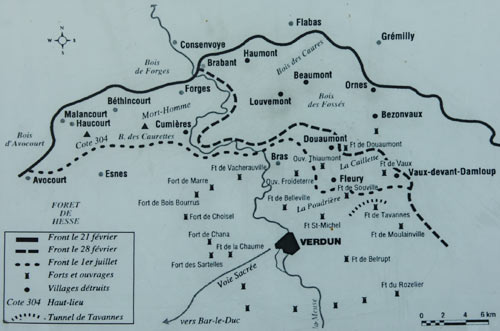
Location plan. Source: Conseil général de la Meuse

Louvemont village destroyed in 1916. Source: Conseil général de la Meuse
Practical information
55100
Louvemont-Côte-du-Poivre
Accessible toute l'année



